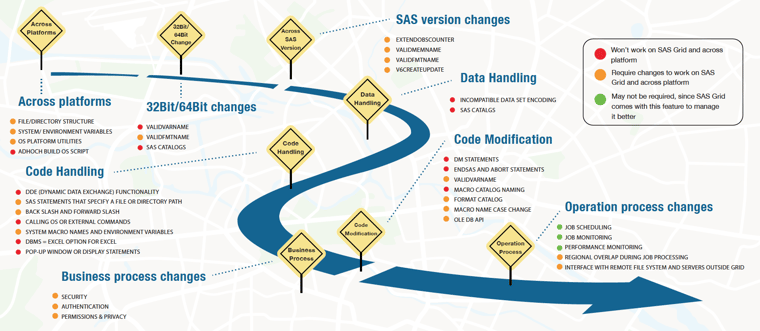SAS programs used for healthcare analysis or clinical trial analysis do not typically warrant the overhead of moving to SAS Grid, especially when you examine a single program or the size of clinical trial data. When you look at the entire organization, however – different departments, varied data volumes, SAS-usage patterns, and the number of processors and SAS licenses that are used ‘part-time’ - routing SAS processing to a SAS Grid cluster starts to seem desirable. Remember, pharmaceutical companies also have groups that do consume large volumes of data or utilize all their processing capability, such as commercial, research modeling, real world evidence, and safety or pharmacovigilance. Healthcare organizations are now analyzing large, complex observational databases, trying to evaluate and improve patient outcomes.

d-Wise has helped several large organizations migrate their SAS systems to the SAS Grid. In most cases, the users were running on a mixture of operating systems and SAS versions. Usually, one operating system is chosen for a client’s SAS Grid servers, which means that some groups may have to change operating systems. In addition, users need to learn how to run SAS in ‘server mode,’ change their batch submission process, and consider the movement of data and results across the network.
Across Platform
Most issues relate to changing operating systems rather than switching to SAS Grid. For example, if you’re switching from Windows to Linux, you’ll need to look for these obvious changes:
- Update file path (such as different names and forward slash and back slash)
- Test out scripting languages such as VBS vs. Linux Shell. Even AIS scripts will not work the same on Linux.
- Replace any “Windows-specific” cleverness, such as DDE and VBS integrations with MS Word.
- Although Excel import and export do work fine, some of the LIBNAME engines are not supported on all operating systems, such as EXCEL and XLSX engines.
- Migrate SAS catalogs. These usually need to be CPORTed on the source system and CIMPORTED into the new system.
Once you lay out the change landscape, accomplished SAS programmers will know where they might encounter problems. Most users can migrate their own programs. If your SAS groups tend to use common folder structures and coding patterns, you can develop tools to scan the folders, convert statements, and create new programs that are ready for testing. d-Wise has done that quite successfully, thereby minimizing manual updates.
The key, however, is planning. If you inventory all your SAS systems, documenting all of the operating systems and versions, you can make reasonable estimates of the effort to migrate to the SAS Grid. It does work.
SAS Grid Migration Roadmap
After implementing SAS Grid, you'll be able to realize a modern, scalable, and consistent computing environment that utilizes your SAS resources more effectively and efficiently. Furthermore, users on SAS Grid can analyze data across a large, geographically disbursed workforce without "location-based" performance impact or license restrictions.
d-Wise recently presented a poster on this topic at the Phuse Annual Conference in Barcelona, Spain in October that highlights some of the stumbling blocks that can be encountered along the migration path to SAS Grid. You can download a copy here.